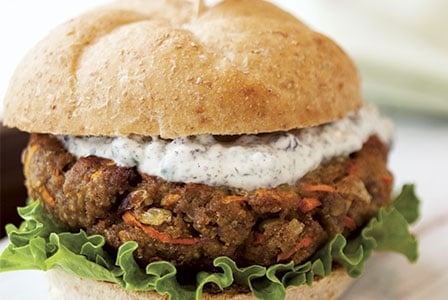
There\’s nothing like a good cup of tea. But tea also adds health benefits and wonderful flavour to chicken, burger, salad, and frozen treat recipes.
For centuries, tea has been valued as a comforting remedy for a variety of ailments. Now that science has confirmed tea’s health benefits, people are enjoying the pleasures of tea drinking with renewed appreciation. Intriguingly, they’re also celebrating the leaf as a delicious and über-healthy culinary ingredient.
The culinary use of tea is not new—in Asia, tea has been used in cooking for hundreds of years. It’s a practice Western cooks are wise to adopt. Not only does adding tea to our dishes impart wonderful flavour, but it also maximizes and enhances our exposure to tea’s many health-promoting compounds.
Health benefits
Tea leaves from the Camellia sinensis plant are teeming with polyphenols. These beneficial compounds have antioxidant activity, and studies show they may reduce the risk for Alzheimer’s disease, cardiovascular disease, cancer, diabetes, osteoporosis, and Parkinson’s disease. If that doesn’t impress you, consider this: a recent animal study indicates the polyphenols in green tea may ameliorate the heart-damaging effects of a high-fat, high-sugar diet. In addition to helping thwart chronic disease, tea can also keep our pearly whites healthy. Recent research has uncovered that tea may help increase the acid resistance in tooth enamel and reduce the risk of gum disease.
Get cooking
There are myriad ways tea can expand our culinary repertoire. Try using the brewed liquid for poaching fish or chicken; cooking grains; or in soups, stews, gravies, and marinades. The leaves can be ground and used as a rub for tofu or poultry or added to baked goods, omelettes, smoothies, spreads, and dressings—the possibilities are as endless as your imagination. (See the sidebar “Tea varieties” for more ideas.) Once you begin cooking with tea, you’ll be delighted by its ability to impart flavour and create memorable meals.
Recipes
- Spicy Turkey Burgers with Minty Yogurt Sauce
- Creamy Strawberry Matcha Pops
- Earl Grey-Infused Edamame Quinoa Salad
- Rooibos Chai Rubbed Chicken with Roasted Red Pepper Sauce
Tea varieties
Selecting a tea for cooking can be a daunting task. Whether you choose a white, green, black, or oolong tea that is blended with spices, flowers, fruits, or other additions, your guide should be your own taste buds and the type of dish you are preparing. One caveat: to reap optimal health benefits, always select organically grown tea.
Here are a few of the more popular teas used in cooking. For additional inspiration switch on your computer—the culinary trend of cooking with tea has spawned several excellent websites and blogs that feature innovative ideas.
Earl Grey
This is a black tea scented with citrusy bergamot oil. Use the brewed tea in place of other liquids when cooking grains or stewing dried fruits. Add the ground leaves to baked goods such as muffins, scones, and shortbread cookies. Try placing an Earl Grey tea bag in melted butter or coconut oil for a few minutes to impart a wonderful citrus note—the resulting infusion is delicious drizzled over poultry or fish!
Matcha
A powdered green tea with a delicate sweet flavour, matcha pairs perfectly with other light, sweet tastes. Try it in baked goods, smoothies, frostings, and cream-based dressings and dips. It also marries well with chocolate.
Assam and Ceylon
These are both assertive black teas whose brews make excellent vegan alternatives to beef stocks and gravies. Their bold, punchy flavour also enhances marinades, stews, and hearty bean dishes.
Oolong
A semi-fermented tea that is a “compromise” between green and black, oolong’s brewed leaves strike an intriguing note when added to omelettes, stir-fries, stews, frittatas, stuffings, and pilafs.
Sencha
Sencha is one of the most common types of green tea. The variety from China is slightly sweeter and better suited for cooking than its Japanese cousin. Its earthy green taste is reminiscent of spinach. The nutritious green leaves make a scrumptious addition to soups, stews, omelettes, and scrambled tofu or eggs.
Jasmine
Jasmine tea refers to any white, black, or green tea that is scented with the heady perfume of jasmine flowers. The aromatic brew combines beautifully with basmati rice and is wonderful for poaching mild-tasting fish such as sole.
Black chai
Any black tea blended with chai spices will make a tasty rub for poultry, fish, or tofu. Chai teas also lend a perfect note to banana- or coconut-based smoothies.
Ginger white
Made from the unopened buds of the Camellia sinensis plant, white tea is the least processed of all the “true” teas and has a mild, sweet taste. The ginger variety is particularly delicious. Use it to cook your morning oatmeal and top with plump raisins and a spoonful of coconut palm sugar for the perfect morning bowl!



